Are you not sure how to clean porcelain tile? Don’t worry, we can help you. Maybe you just learned how to tile and installed some porcelain tiles to revamp your kitchen or bathroom, maybe you’ve paid a professional to do it for you. Either way, if you’re not sure where to start then you’re in the right place.
If done correctly, your floor and shower tiles will sparkle like never before. Because porcelain tiles naturally have antimicrobial properties, learning how to clean porcelain tiles isn’t too difficult and is worth the effort.
Our guide has everything you need to know about how to clean porcelain tile. From everyday grime removal to removing soap scum build-up in hard-to-reach areas, you’ll learn our expert tactics to make your porcelain shine as good as new.

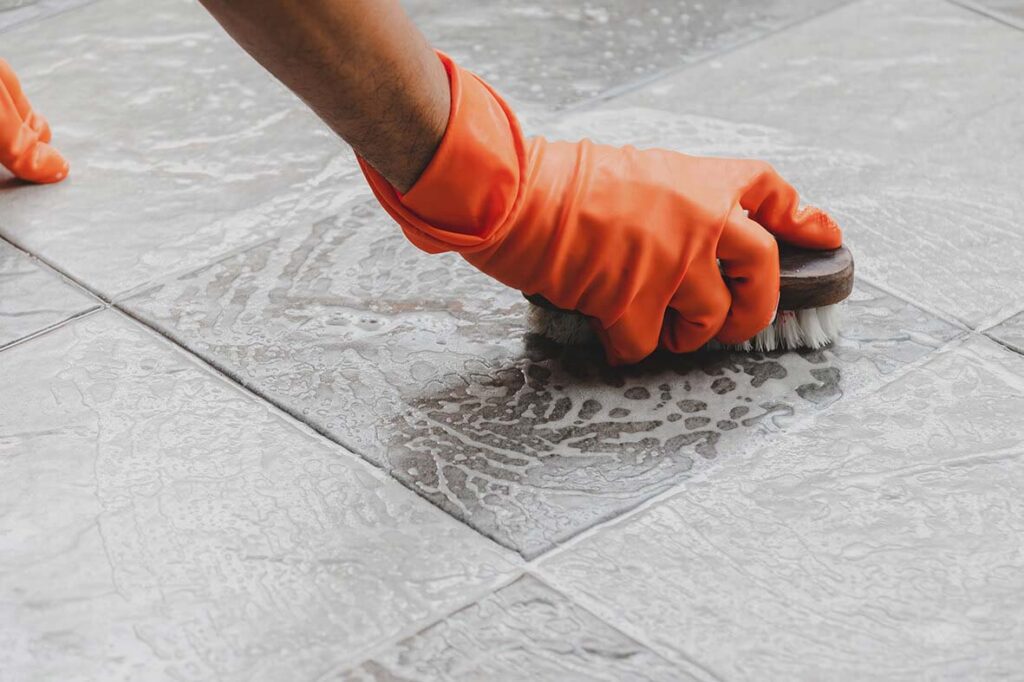
BENEFITS OF PORCELAIN TILE
Installing porcelain tile in your home has many benefits. This type of tile is durable, long-lasting, and waterproof. This makes it an obvious choice to use in wetter areas of the home, like kitchens and bathrooms. Other benefits of porcelain tile installation include the following.
BACTERIA RESISTANCE
Porcelain tile surfaces are low-maintenance. They are a non-porous material which is naturally inhospitable to bacteria and hazardous moulds.
Their impermeable quality blocks the potential passage of harmful microbes to the tile’s substrate area. This makes them suitable for public places, such as hospitals, where intensive cleaning is necessary. However, they’re great for homes and businesses, too.
This hardness, combined with the natural resistance of glazing, makes them tough enough to withstand daily cleaning with harsh chemicals and sanitizing solvents.
While you don’t have to use harsh chemicals (which we’ll explain below), it is tough enough to withstand frequent cleaning with sanitizing solvents in professional or medical settings where that level of cleaning is required.
HYPOALLERGENIC
Porcelain tile is an ideal flooring option for those who suffer from allergies due to its hypoallergenic properties.
The material contains no allergens that could trigger respiratory symptoms in those with allergies or asthma. Plus, the surface blocks allergens in the environment from sticking or accumulating on the surface, effectively avoiding potential allergen exposure in the home.
WATER RESISTANCE
Porcelain tile is known for its remarkable water resistance, which makes it an ideal choice for areas prone to spills or moisture. Unlike other tiles, porcelain can withstand excess moisture without staining or deteriorating quality.
Furthermore, porcelain has the highest waterproofing rating of any natural material. If you notice product descriptions, you’ll see it’s listed as “impervious.” This means the water absorption rate is less than 0.5%, so the liquid won’t seep into the surface and damage your tiles. Basically, this is why it’s so great for bathrooms and kitchens.
EASY CLEANING
What is the biggest benefit of installing porcelain tiles for most homeowners? It’s remarkably easy to clean, so you won’t have to reach for harsh chemicals. Generally, water alone works great for routine cleaning.
Plus, porcelain tile surfaces are well-protected against different types of wear and tear, such as stains, scratches, scrapes, dents, or cuts. As a material, porcelain tile is hefty and durable yet requires minimal effort to keep it looking good. It doesn’t get much better than that.
HOW OFTEN TO CLEAN PORCELAIN TILE
For best results, give your porcelain tile a quick once-over at least once a week. This will prevent the build-up of dirt and grime that can erode the finish.
Are you planning on cleaning weekly? Start by sweeping or vacuuming away dust, dirt, and crumbs to clean the surface. Then wipe down the tile with clean water. Water is often enough to remove lighter soiling without using other cleaners.
However, mopping is acceptable, too, if necessary. Just make sure that the floor has been swept first. Then use a flat mop rather than a sponge mop to avoid pushing excess water into the grout lines. Finally, let the floor fully dry so that no lingering liquid remains on the surface.
WHAT’S THE BEST WAY TO CLEAN PORCELAIN TILE?
The type of tile can dictate the best way to clean it.
For example, unglazed or unpolished porcelain tiles respond better to mild soaps and warm water mixtures, while glazed or polished tile often does well with a commercially available porcelain cleaner. Textured porcelain tiling might require extra scrubbing to remove dirt and debris from the grouting between the tiles.
Regardless of your type, cleaning your porcelain tile regularly will minimize wear and tear while keeping your interior spaces fresh and beautiful.
HOW TO CLEAN PORCELAIN TILE
Cleaning porcelain tile isn’t complicated. However, as mentioned above, your cleaning method varies depending on the type of tile you’re cleaning. Follow along as we guide you step-by-step through how to clean porcelain tile, depending on the type you have.
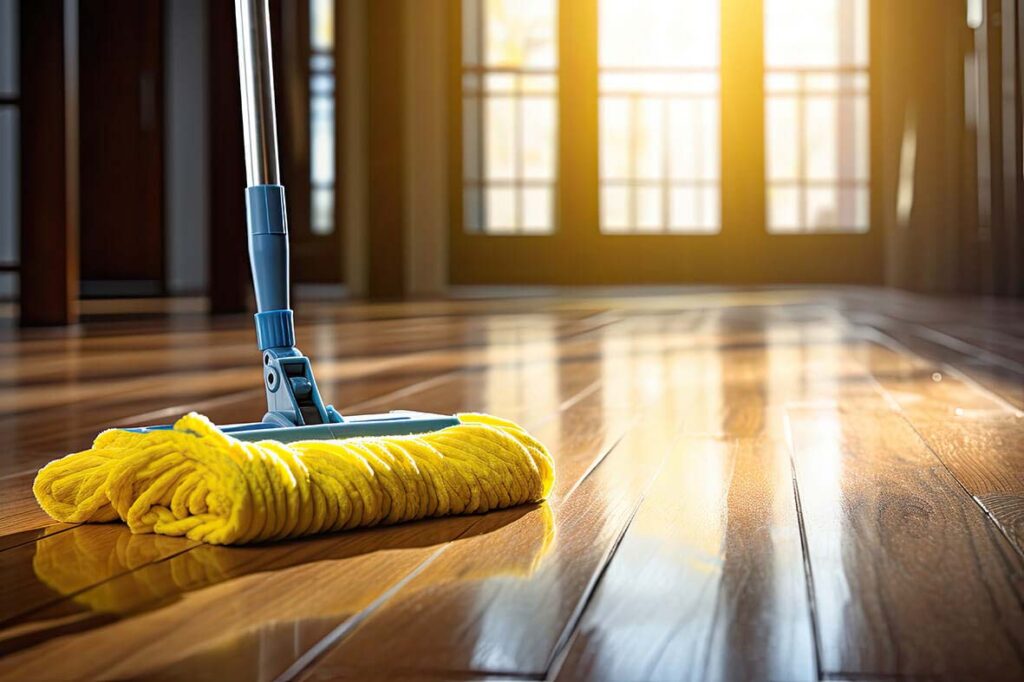
UNPOLISHED OR UNGLAZED TILE
Unglazed porcelain tiles are more prone to staining than glazed ones, so you should expect to clean them more often to avoid discolorations.
Vacuuming and sweeping will help remove loose dirt and debris between tiles and grout lines. Focus on one section at a time (about two or four feet square) while you’re doing this step.
You’ll want to cover the tile surface with a vinegar-and-water mixture or a commercial cleanser. Why these two types of solutions?
The vinegar-and-water solution helps break down grease and oil residue while effectively disinfecting. In contrast, the commercial cleanser should be used sparingly due to potential discoloration of grout lines if overused — especially on light-coloured tiles like white or cream ones!
Once it’s soaked for a while, use a soft-bristle brush to remove any particularly stubborn spots without causing damage to the tile itself. Rinsing with hot water helps finish off by removing all traces of dirt left behind during cleaning sessions.
Finally, dry the tile properly. Finishing up with a proper drying session using towels or microfiber cloths ensures no moisture is left behind. While the tile is water resistant, the areas around it might not be, so it’s best to dry everything just in case.
POLISHED OR GLAZED TILE
Using the right combination of tools and products is important for thoroughly cleaning polished or glazed porcelain tile. Begin by sweeping and vacuuming the area to remove dirt and debris, then dust-mopping the tile with a dry mop.
Then use a hot water-dampened mop to loosen heavy soil before tackling stubborn stains with a heavy-duty cleanser. If you prefer something all-natural, stick to the vinegar-and-water mixture mentioned above.
Mop once more with hot water before the cleaner dries, and then use either a clean towel or microfiber cloth to dry the tile surface taking care to rub out any water spots.
Once all moisture has been removed, buff the surface using cheesecloth for an extra shine. To ensure lasting results, carry out these steps regularly on your porcelain tiles, adhering to the manufacturer’s instructions where applicable.

TEXTURED TILE
To ensure a brilliant and sparkling clean textured porcelain tile, follow these steps below.
As with other types of porcelain tile, you’ll want to begin by sweeping the area twice with a soft-bristle broom. Sweep in both straight and diagonal directions. Then use a vacuum cleaner to remove any dirt or particles from the surface.
Next, make your water and vinegar solution as mentioned in the cleaning instructions above. Spray it or spread it across your textured tile. Allow the tile to soak for five to ten minutes before scrubbing using a soft-bristled brush or an old toothbrush.
After that, rinse the cleaning solution with hot water before going over the floor with a damp mop. Finally, dry the porcelain tile with a clean towel or a microfiber cloth as soon as possible to prevent water spots from taking hold.
Make this a routine, and you’ll keep your porcelain tile looking shiny and new!
HOW TO DISINFECT PORCELAIN TILE
Cleaning your tiles is one thing. But what if you need to disinfect them? Fortunately, you don’t need harsh chemicals or solutions to disinfect porcelain tiles. Warm water and an appropriate non-abrasive cleaner are all you need most of the time.
For situations requiring a greater level of cleanliness, such as when dealing with mould in the grout lines or silicone sealant around the edges of your tiles, you can use stronger disinfectants and cleaning products without fear of staining or damaging the surface of the tiles.
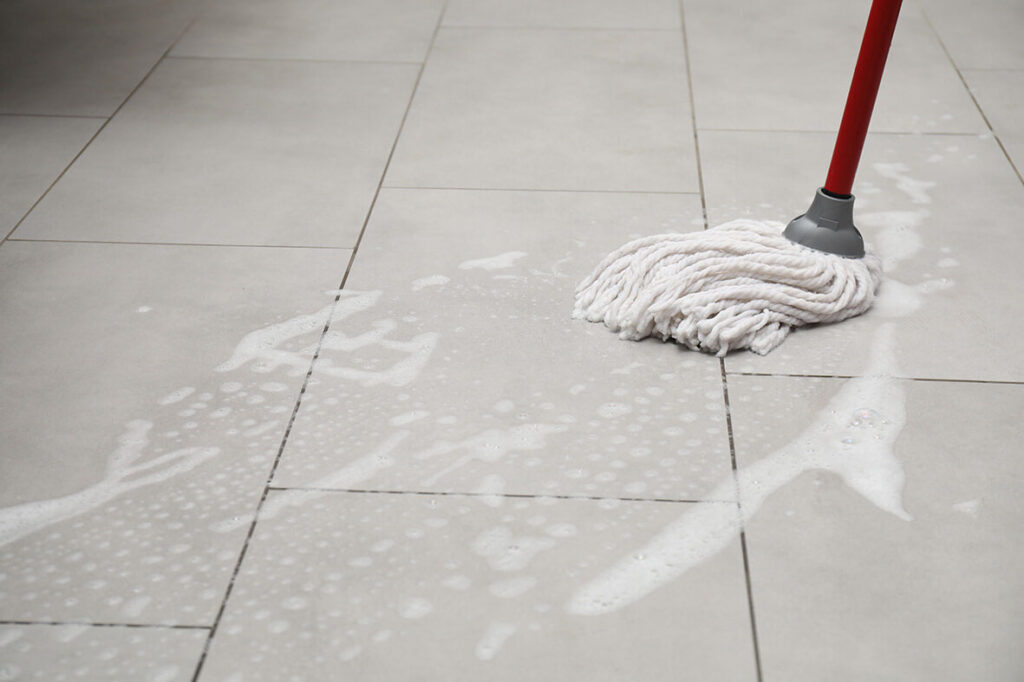
Are you unsure which one to use? Consulting with professionals is the best way forward. It is never recommended to mix chemicals, especially if you are uncertain of which to use.
WHAT NOT TO DO WHEN CLEANING PORCELAIN TILE
As mentioned above, porcelain tiles are incredibly durable. However, you’ll want to avoid certain cleaners and techniques to ensure the tile and grout remain pristine. This doesn’t just apply to home projects. That’s the case with professional tiling, too.
Namely, ammonia or bleach-based solutions can cause grout staining. Oil detergents and wax-based products can also affect the tile’s integrity. You’ll also want to steer clear of cleaners containing dyes or colouring if you’re cleaning unglazed tiles. Steel wool is also a major no-no when cleaning porcelain, as small fragments can become lodged in the tile and cause rust stains over time.
Lastly, avoid hard-bristled scrub brushes or anything else abrasive. These can leave scratches on the surface of your beautiful porcelain tile.
NEED HELP INSTALLING PORCELAIN TILES?
While learning how to clean porcelain tile ensures your tiles stay shiny for a long time, these tips won’t help much if you can’t finish your tile installation project. Luckily, we’ve got just the tools you need.
At Rubi, we have everything you need, from tile spacers and cutters to more. Click here to view our full product catalogue, or browse our site to view our selection of tiling tools.
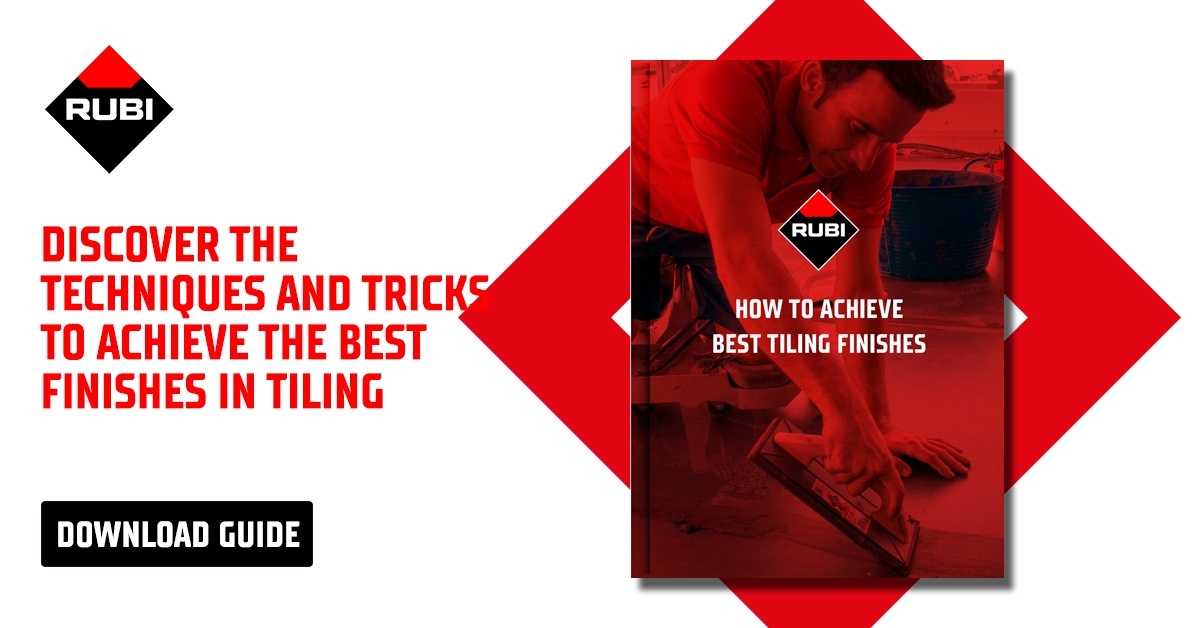

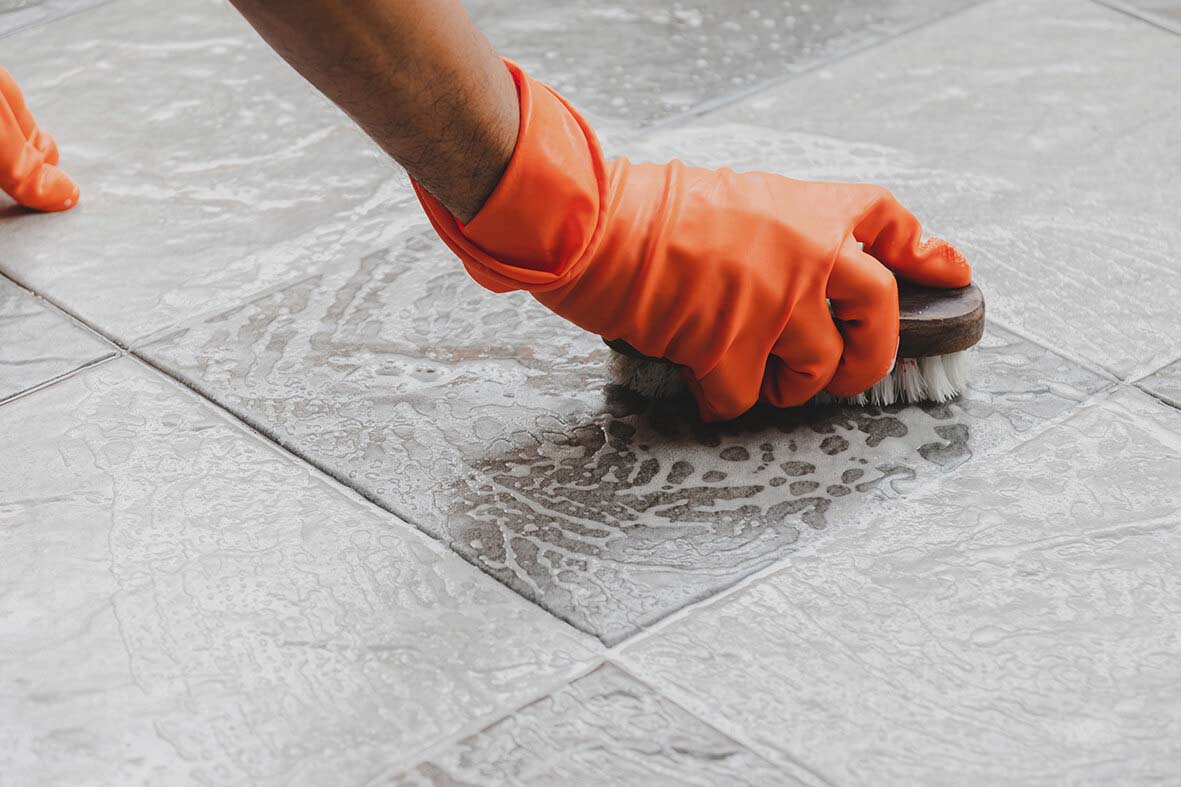
Post a comment